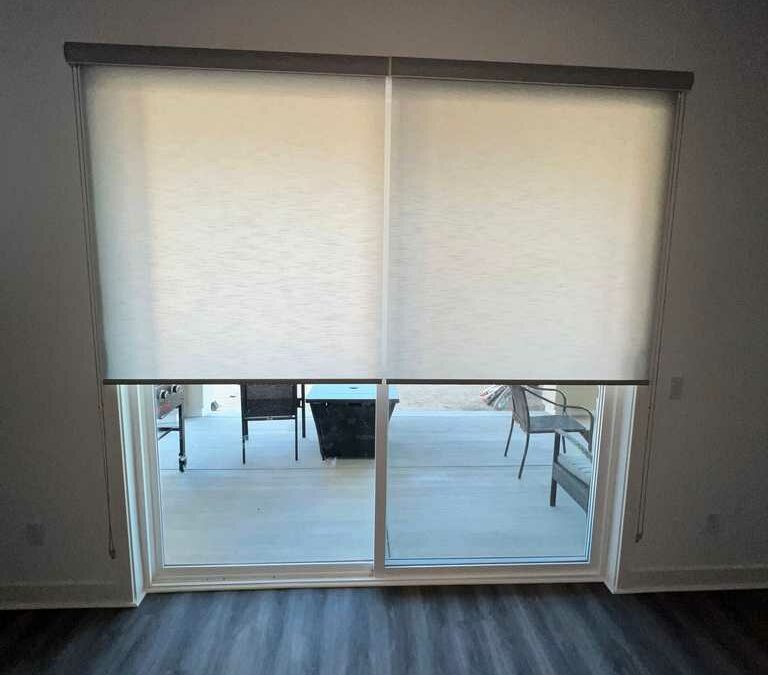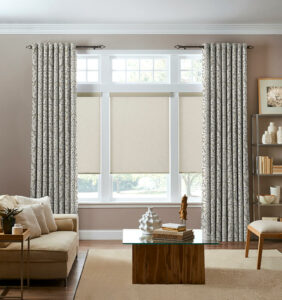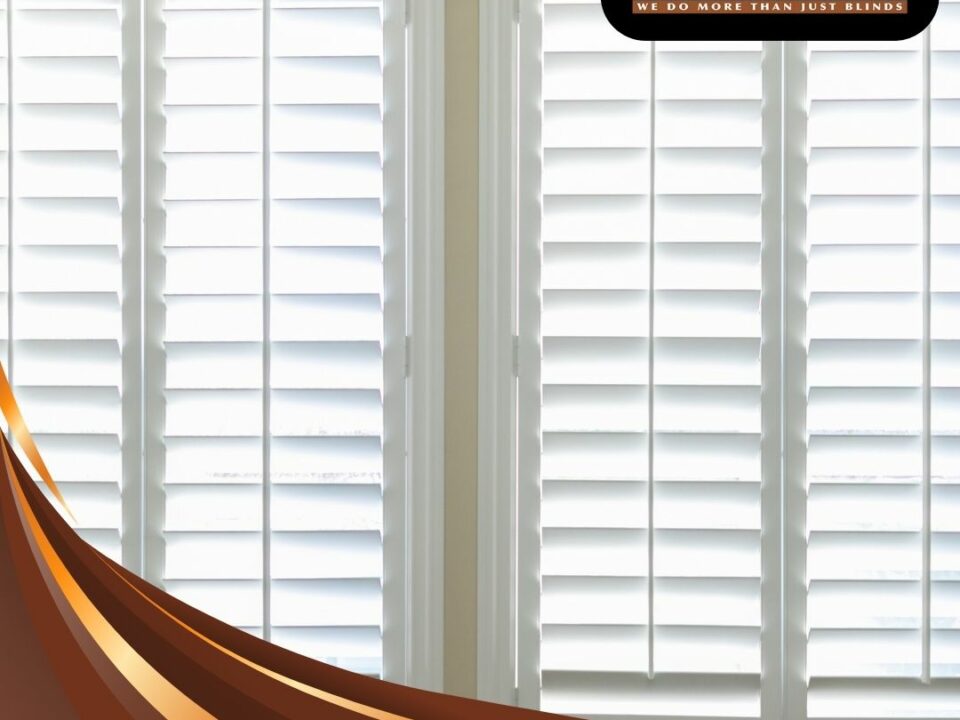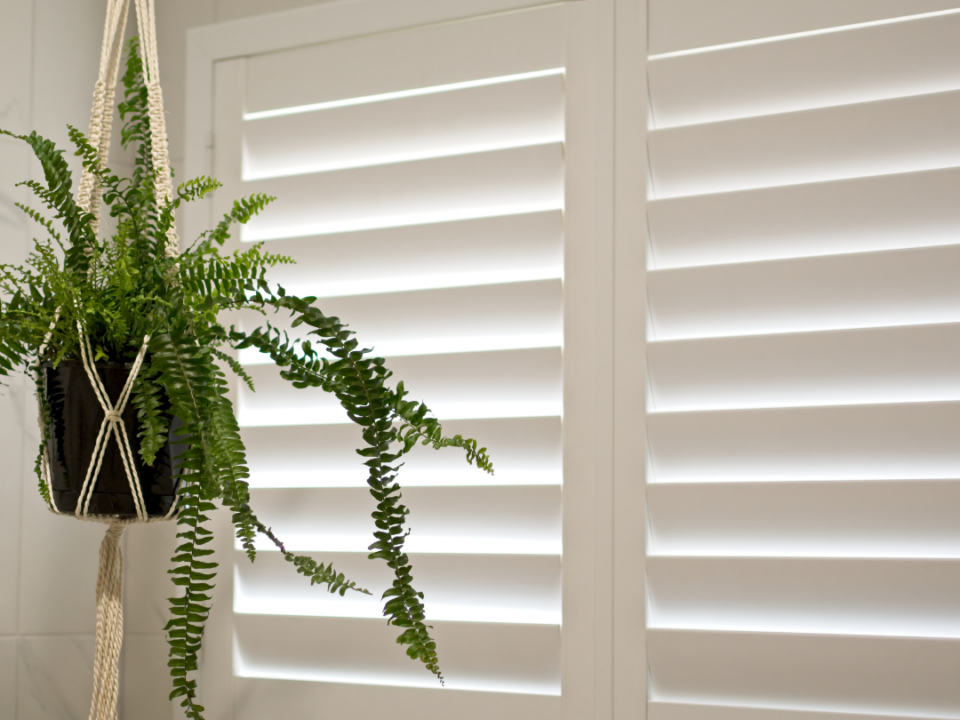There are a lot of things to consider when you’re selecting the best plantation shutters for your home.
There’s the style, louver size and color. Then there’s the material, which impacts your shutters’ appearance and cost.
Getting your shutters right is the most important part of the process. When you work with a professional like us, it’s often the easiest part of the process.
The Best Plantation Shutter Materials
Here are a few of the most popular materials for plantation shutters, and why some are a better choice than others.
Hardwood
Hardwood is a premium plantation shutter material. It’s among the lightest and most durable, although it’s not well-suited for rooms with excess humidity or moisture.
Quality shutters will be made from furniture-grade woods like basswood or poplar. These lightweight woods have a stunning natural beauty and richly retain paint or stain.
Most people outside of the woodworking industry don’t know what furniture-grade means, but it’s important when it involves your shutters.
Before leaving the lumber mill, each piece of wood is graded based on knots, cracks, grain slope and moisture content. Furniture-grade wood is considered the finest type of wood you can get.
Here are a few benefits of choosing shutters made from this type of wood:
Blemish-free
Lasts longer
Looks better
Resists splintering, warping and bleeding
If you’re looking for custom shutters that make an elegant statement, selecting high-quality genuine wood like our Heritage Shutters is a great idea.
Faux Wood
Faux wood is one of the most popular styles of plantation shutters. Modern versions look just like wood, but often cost less and provide superior insulation.
They’re also lightweight and suited for rooms with high humidity and moisture, such as a bathroom or kitchen. It’s also a great choice if you live near the ocean, since intense rays and saltwater can deteriorate real wood.
Good faux wood shutters should be able to weather the elements without chipping, cracking or peeling. They also shouldn’t warp, bend or need to be adjusted.
Hybrid with Wood and Faux Wood
Hybrid shutters give you the best of both worlds, since they incorporate premium features at a fantastic value.
Like our Classic Shutters, they usually have an extra-strong hardwood frame and energy-efficient faux wood louvers. That way, you get a classic look and energy efficiency you might even notice on your heating and cooling bill.
The best hybrid shutters will be made from high-quality wood and a dense synthetic.
Vinyl
Vinyl is among the least expensive materials for plantation shutters. While it’s weather- and moisture-resistant, it’s prone to structural problems.
If you’re on a tight budget, you might be tempted to use hollow vinyl shutters. But you should be aware this material usually sags over time, since this type of shutter isn’t reinforced.
Because of this, it’s also not a good option for big windows.
Composites
Another inexpensive material choice for plantation shutters is engineered wood, like MDF, composite or laminate.
While these materials are cost effective, they are not as durable to wear and tear. MDF, for example, is made from a combination of sawdust and glue.
Many of these materials are not moisture-resistant, making them a poor choice for humid climates. Humidity can break them down faster, so you might end up replacing your shutters sooner than you thought you would.
There are a lot of things to consider when you’re selecting the best plantation shutters for your home.
There’s the style, louver size and color. Then there’s the material, which impacts your shutters’ appearance and cost.
Getting your shutters right is the most important part of the process. When you work with a professional like us, it’s often the easiest part of the process.
The Best Plantation Shutter Materials
Here are a few of the most popular materials for plantation shutters, and why some are a better choice than others.
Hardwood
Hardwood is a premium plantation shutter material. It’s among the lightest and most durable, although it’s not well-suited for rooms with excess humidity or moisture.
Quality shutters will be made from furniture-grade woods like basswood or poplar. These lightweight woods have a stunning natural beauty and richly retain paint or stain.
Most people outside of the woodworking industry don’t know what furniture-grade means, but it’s important when it involves your shutters.
Before leaving the lumber mill, each piece of wood is graded based on knots, cracks, grain slope and moisture content. Furniture-grade wood is considered the finest type of wood you can get.
Here are a few benefits of choosing shutters made from this type of wood:
Blemish-free
Lasts longer
Looks better
Resists splintering, warping and bleeding
If you’re looking for custom shutters that make an elegant statement, selecting high-quality genuine wood like our Heritage Shutters is a great idea.
Faux Wood
Faux wood is one of the most popular styles of plantation shutters. Modern versions look just like wood, but often cost less and provide superior insulation.
They’re also lightweight and suited for rooms with high humidity and moisture, such as a bathroom or kitchen. It’s also a great choice if you live near the ocean, since intense rays and saltwater can deteriorate real wood.
Good faux wood shutters should be able to weather the elements without chipping, cracking or peeling. They also shouldn’t warp, bend or need to be adjusted.
Hybrid with Wood and Faux Wood
Hybrid shutters give you the best of both worlds, since they incorporate premium features at a fantastic value.
Like our Classic Shutters, they usually have an extra-strong hardwood frame and energy-efficient faux wood louvers. That way, you get a classic look and energy efficiency you might even notice on your heating and cooling bill.
The best hybrid shutters will be made from high-quality wood and a dense synthetic.
Vinyl
Vinyl is among the least expensive materials for plantation shutters. While it’s weather- and moisture-resistant, it’s prone to structural problems.
If you’re on a tight budget, you might be tempted to use hollow vinyl shutters. But you should be aware this material usually sags over time, since this type of shutter isn’t reinforced.
Because of this, it’s also not a good option for big windows.
Composites
Another inexpensive material choice for plantation shutters is engineered wood, like MDF, composite or laminate.
While these materials are cost effective, they are not as durable to wear and tear. MDF, for example, is made from a combination of sawdust and glue.
Many of these materials are not moisture-resistant, making them a poor choice for humid climates. Humidity can break them down faster, so you might end up replacing your shutters sooner than you thought you would.
There are a lot of things to consider when you’re selecting the best plantation shutters for your home.
There’s the style, louver size and color. Then there’s the material, which impacts your shutters’ appearance and cost.
Getting your shutters right is the most important part of the process. When you work with a professional like us, it’s often the easiest part of the process.
The Best Plantation Shutter Materials
Here are a few of the most popular materials for plantation shutters, and why some are a better choice than others.
Hardwood
Hardwood is a premium plantation shutter material. It’s among the lightest and most durable, although it’s not well-suited for rooms with excess humidity or moisture.
Quality shutters will be made from furniture-grade woods like basswood or poplar. These lightweight woods have a stunning natural beauty and richly retain paint or stain.
Most people outside of the woodworking industry don’t know what furniture-grade means, but it’s important when it involves your shutters.
Before leaving the lumber mill, each piece of wood is graded based on knots, cracks, grain slope and moisture content. Furniture-grade wood is considered the finest type of wood you can get.
Here are a few benefits of choosing shutters made from this type of wood:
Blemish-free
Lasts longer
Looks better
Resists splintering, warping and bleeding
If you’re looking for custom shutters that make an elegant statement, selecting high-quality genuine wood like our Heritage Shutters is a great idea.
Faux Wood
Faux wood is one of the most popular styles of plantation shutters. Modern versions look just like wood, but often cost less and provide superior insulation.
They’re also lightweight and suited for rooms with high humidity and moisture, such as a bathroom or kitchen. It’s also a great choice if you live near the ocean, since intense rays and saltwater can deteriorate real wood.
Good faux wood shutters should be able to weather the elements without chipping, cracking or peeling. They also shouldn’t warp, bend or need to be adjusted.
Hybrid with Wood and Faux Wood
Hybrid shutters give you the best of both worlds, since they incorporate premium features at a fantastic value.
Like our Classic Shutters, they usually have an extra-strong hardwood frame and energy-efficient faux wood louvers. That way, you get a classic look and energy efficiency you might even notice on your heating and cooling bill.
The best hybrid shutters will be made from high-quality wood and a dense synthetic.
Vinyl
Vinyl is among the least expensive materials for plantation shutters. While it’s weather- and moisture-resistant, it’s prone to structural problems.
If you’re on a tight budget, you might be tempted to use hollow vinyl shutters. But you should be aware this material usually sags over time, since this type of shutter isn’t reinforced.
Because of this, it’s also not a good option for big windows.
Composites
Another inexpensive material choice for plantation shutters is engineered wood, like MDF, composite or laminate.
While these materials are cost effective, they are not as durable to wear and tear. MDF, for example, is made from a combination of sawdust and glue.
Many of these materials are not moisture-resistant, making them a poor choice for humid climates. Humidity can break them down faster, so you might end up replacing your shutters sooner than you thought you would.
There are a lot of things to consider when you’re selecting the best plantation shutters for your home.
There’s the style, louver size and color. Then there’s the material, which impacts your shutters’ appearance and cost.
Getting your shutters right is the most important part of the process. When you work with a professional like us, it’s often the easiest part of the process.
The Best Plantation Shutter Materials
Here are a few of the most popular materials for plantation shutters, and why some are a better choice than others.
Hardwood
Hardwood is a premium plantation shutter material. It’s among the lightest and most durable, although it’s not well-suited for rooms with excess humidity or moisture.
Quality shutters will be made from furniture-grade woods like basswood or poplar. These lightweight woods have a stunning natural beauty and richly retain paint or stain.
Most people outside of the woodworking industry don’t know what furniture-grade means, but it’s important when it involves your shutters.
Before leaving the lumber mill, each piece of wood is graded based on knots, cracks, grain slope and moisture content. Furniture-grade wood is considered the finest type of wood you can get.
Here are a few benefits of choosing shutters made from this type of wood:
Blemish-free
Lasts longer
Looks better
Resists splintering, warping and bleeding
If you’re looking for custom shutters that make an elegant statement, selecting high-quality genuine wood like our Heritage Shutters is a great idea.
Faux Wood
Faux wood is one of the most popular styles of plantation shutters. Modern versions look just like wood, but often cost less and provide superior insulation.
They’re also lightweight and suited for rooms with high humidity and moisture, such as a bathroom or kitchen. It’s also a great choice if you live near the ocean, since intense rays and saltwater can deteriorate real wood.
Good faux wood shutters should be able to weather the elements without chipping, cracking or peeling. They also shouldn’t warp, bend or need to be adjusted.
Hybrid with Wood and Faux Wood
Hybrid shutters give you the best of both worlds, since they incorporate premium features at a fantastic value.
Like our Classic Shutters, they usually have an extra-strong hardwood frame and energy-efficient faux wood louvers. That way, you get a classic look and energy efficiency you might even notice on your heating and cooling bill.
The best hybrid shutters will be made from high-quality wood and a dense synthetic.
Vinyl
Vinyl is among the least expensive materials for plantation shutters. While it’s weather- and moisture-resistant, it’s prone to structural problems.
If you’re on a tight budget, you might be tempted to use hollow vinyl shutters. But you should be aware this material usually sags over time, since this type of shutter isn’t reinforced.
Because of this, it’s also not a good option for big windows.
Composites
Another inexpensive material choice for plantation shutters is engineered wood, like MDF, composite or laminate.
While these materials are cost effective, they are not as durable to wear and tear. MDF, for example, is made from a combination of sawdust and glue.
Many of these materials are not moisture-resistant, making them a poor choice for humid climates. Humidity can break them down faster, so you might end up replacing your shutters sooner than you thought you would.








